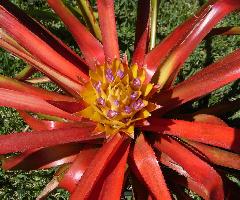
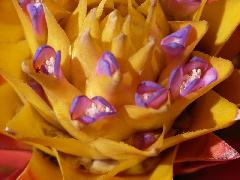
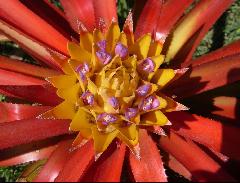
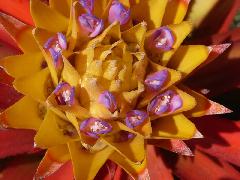
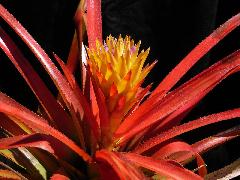
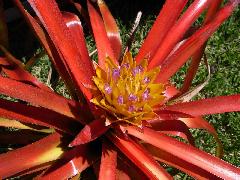
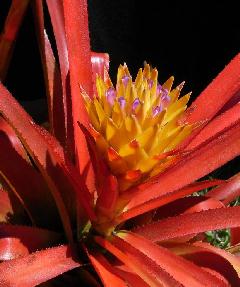
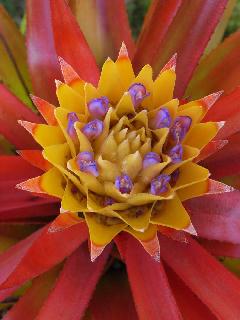
Plant stemless, propagating by short stolons.
Leaves numerous, forming a spreading rosette of a diameter of 1-1.2 m (in cultivation);
Sheaths conspicuous and merging with the blades, up to 5 cm wide and 10 cm high, dark castaneous-brown in the basal half, green in the upper half with even margins.
Blades 50-60 cm long, subligulate, above the sheath 2 cm wide, attenuate to a pungent tip, slightly canaliculate, sublaxly serrulate with greenish-brown, spreading spines 2 mm long, when young laxly lepidote, later glabrous and then lustrous.
Inner rosette leaves erect at anthesis bright red, postfloral turning to green.
Scape short, postfloral ± 8 cm long, 1.5 cm thick, green glabrous.
Scape bracts subfoliate, erect, longer than the inflorescence, with a short, broad, ovate sheath; this is 3 cm wide and 2 cm high, greenish, blades bright carmine-red, gradually transforming into the primary bracts.
Inflorescence much shorter than the rosette leaves and the basal scape bracts, subcapitate, bipinnate, up to 7 cm long and 8 cm in diameter.
Primary bracts densely spirostichous, the basal (outer) ones broad-triangular with an excavate sheath; this is 4 cm wide and 2 cm high, pale lemon-yellow; the blade 5-6 cm long, in the basal half orange-yellow, in the upper one bright carmine-red, densely lepidote and denticulate at the margin. Upper (inner) primary bracts smaller than the outer ones, uniform orange-yellow, minutely dentate and cucullate at the tip; all primary bracts much exceeding the 2-flowered subsessile spikes.
Floral bracts membranous, thin, extremely carinate, apiculate, dentate at the keel, 1/3 longer than the ovary, but much shorter than the sepals. These are slightly asymmetric, mucronate, l2-15 mm long, the apex very finely obconic;
Petals up to 35 mm long, naked, pale blue-violet (not pink as observed by Dodson and Thien).
Stamens and style included;
Ovary angled, 1 cm thick, 0.7 cm high; ovules subapical, obtuse.
The plant is known only from the type-locality. It was first (1962) collected by Dodson and Thien, No.2070, along the Rio Tope in a tropical rain forest near Topo, Pastaza, East Ecuador, at an altitude of 1300 m. We collected our plant near Lago Agrio, Dptm. Napa, in a wet forest, growing terrestrially at an altitude of 600 m, collecting no. B.G.H. 65480, 1984.